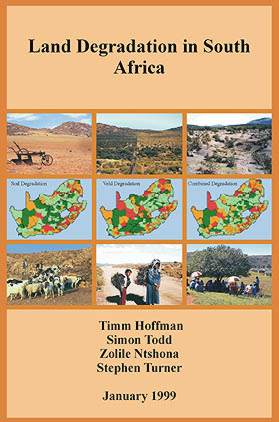First draft January 1999: revision due to be completed end-2000

South Africa has a long history of desertification research which stretches back to the last century. The main themes within this research, however, have never been synthesized into a single document incorporating the literature on water, soil and veld degradation in both commercial and communal areas of South Africa. Also, the most important socio-economic reasons for land degradation are often not discussed.
This project has employed a multi-disciplinary team of biophysical and social scientists to develop an integrated assessment of South Africa's land degradation literature.
The literature review is comprised of 11 chapters plus a list of references. Each chapter may be downloaded separately in zipped MS Word 97 format, or the complete review may be downloaded in zipped plain-text format. The latter excludes the imbedded figures and maps, for obvious reasons, but is significantly quicker to download.
Chapter Summaries
Executive Summary, Preface, Acknowledgments and Table of Contents
A short summary of each of the chapters is provided for quick reference. Maps showing the extent of soil and vegetation degradation in South Africa and a combined index of soil and vegetation degradation are also included.
Download the full version
Chapter 1: Land Degradation in Context
This introductory chapter outlines the objective of this review provides a brief historical overview of land degradation in South Africa. It also discusses the role played by the UNCCD in South Africa.
Author: M.T. Hoffman, National Botanical Institute (NBI)
Download the full version
In chapter 2 the approach and conceptual framework adopted for the study are clarified. The definitions for desertification and those of the UNCCD for "affected drylands" are discussed.
Author: M.T. Hoffman, National Botanical Institute (NBI)
Download the full version
Chapter 3: The South African Environment and Landuse
Here the South African biophysical, socio-economic and agricultural environment is described for international and local readers, and dominant land use practices are outlined.
Authors: M.T. Hoffman & S.W.Todd, National Botanical Institute (NBI)
Download the full version
Chapter 4: Degradation of Surface Water Resources
This chapter discusses how the pressures of population growth, increased agricultural and industrial activities, and urban sprawl have led to the degradation of many of the surface water resources of South Africa.
Author: C. Snaddon, University of Cape Town, Freshwater Research Unit
Download the full version
Chapter 5: Degradation of Groundwater Resources
Although this overview has not been able to indicate that there is any large-scale degradation of either quantity delivered or the quality of groundwater, this chapter discusses how groundwater resources in South Africa are recharged according to the amount of rainfall in an area.
Authors: K.O.Bang & C. Stimie, Institute for Soil, Climate and Water (ISCW)
Download the full version
This review concentrates on soil erosion but where relevant includes mention of salinization, acidification, water logging, soil pollution, soil mining and compaction as they may also influence desertification.
Authors: G. Garland, Department of Environmental and Geographical Sciences, University of Natal & M.T. Hoffman & S.W.Todd, National Botanical Institute (NBI)
Download the full version
Chapter 7: Vegetation Degradation
An overview of veld degradation in South Africa and the main types of degradation are provided. The issue of declining veld condition, the extent of bush encroachment, alien plant invasions and deforestation are discussed separately.
Authors: M.T. Hoffman & S.W.Todd, National Botanical Institute (NBI) & D. le Maitre, Water, Environment and Forestry Technology.
Download the full version
Chapter 8: A Combined Index of Degradation
This chapter shows how the soil and vegetation indices can be combined to form a single index, indicating several key areas of degradation in South Africa.
Authors: M.T. Hoffman & S.W.Todd, National Botanical Institute (NBI)
Download the full version
Chapter 9: Causes of Degradation
This chapter outlines degradation as caused by both (a) climate and (b) people.
Authors: (a) M.T. Hoffman & S.W.Todd, National Botanical Institute(NBI)
(b) S.D. Turner & Z Ntshona, Programme for Land and Agrarian Studies (PLAAS)
Download the full version
Chapter 10: Correlates and Models of Degradation
In this chapter a set of 31 variables are outlined. These varaibles define each of the 367 magisterial districts in South Africa in terms of their biophysical environment and climate, land use and land tenure systems, demography, labour, employment and economic production indicators. Regression models are used to develop our understanding of the main correlates of land degradation in South Africa.
Authors: M.T. Hoffman & S.W.Todd, National Botanical Institute (NBI)
Download the full version
Here the main conclusions from this study are provided.
Author: M.T. Hoffman, National Botanical Institute (NBI) & S.D. Turner, Programme for Land and Agrarian Studies (PLAAS)
Download the full version
Download the full version
